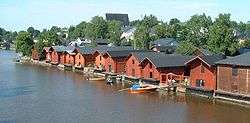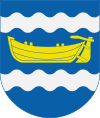Porvoo
| Porvoo Porvoo – Borgå | ||
|---|---|---|
| City | ||
| Porvoon kaupunki Borgå stad | ||
|
Riverside storage buildings in Old Porvoo in July 2004 | ||
| ||
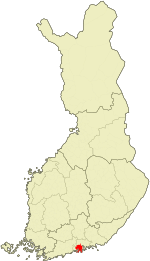 | ||
| Country | Finland | |
| Region | Uusimaa | |
| Sub-region | Porvoo sub-region | |
| City rights | ca. 1380 | |
| Government | ||
| • City manager | Jukka-Pekka Ujula | |
| Area (2011-01-01)[1] | ||
| • Total | 2,139.19 km2 (825.95 sq mi) | |
| • Land | 654.70 km2 (252.78 sq mi) | |
| • Water | 1,484.49 km2 (573.16 sq mi) | |
| Area rank | 38th largest in Finland | |
| Population (2016-03-31)[2] | ||
| • Total | 50,037 | |
| • Rank | 21st largest in Finland | |
| • Density | 76.43/km2 (198.0/sq mi) | |
| Population by native language[3] | ||
| • Finnish | 64.9% (official) | |
| • Swedish | 31.6% (official) | |
| • Others | 3.5% | |
| Population by age[4] | ||
| • 0 to 14 | 18.5% | |
| • 15 to 64 | 67% | |
| • 65 or older | 14.5% | |
| Time zone | EET (UTC+2) | |
| • Summer (DST) | EEST (UTC+3) | |
| Municipal tax rate[5] | 19.25% | |
| Climate | Dfb | |
| Website | www.porvoo.fi | |
Porvoo (Finnish pronunciation: [ˈporʋoː]; Swedish: Borgå [ˈbɔrɡo]) is a city and a municipality situated on the southern coast of Finland approximately 50 kilometres (30 mi) east of Helsinki. Porvoo is one of the six medieval towns in Finland, first mentioned as a city in texts from 14th century. Porvoo is the seat of the Swedish-speaking Diocese of Borgå of the Evangelical Lutheran Church of Finland.
The municipality's official languages are Finnish and Swedish. In 2014, 64.6% of the population spoke Finnish as their mother tongue, while 30.1% were Swedish speakers. 5.4% had a different mother tongue.
Neighbouring municipalities: Askola, Loviisa, Myrskylä, Pornainen and Sipoo.
History
Porvoo was first mentioned in documents in the early 14th century, and Porvoo was given city rights around 1380, even though according to some sources the city was founded in 1346. The old city of Porvoo was formally disestablished and the new city of Porvoo founded in 1997 when the city of Porvoo and the Rural municipality of Porvoo were consolidated.[6] When Sweden lost the city of Viborg to Russia in 1721, the episcopal seat was moved to Porvoo. At this time, Porvoo was the second largest city in Finland. After the conquest of Finland by Russian armies in 1808 Sweden had to cede Finland to Russia in 1809 (the Treaty of Fredrikshamn). The Diet of Porvoo in 1809 was a landmark in the History of Finland. The Tsar Alexander I confirmed the new Finnish constitution (which was essentially the Swedish constitution from 1772), and made Finland an autonomous Grand Duchy.
The Porvoo Common Statement is a report issued at the conclusion of theological conversations by official representatives of four Anglican Churches and eight Nordic and Baltic Lutheran Churches in 1989–1992. It established the Porvoo Communion, so named after the Porvoo Cathedral where the Eucharist was celebrated on the final Sunday of the conversations leading to the Statement.
Name
The town received its name from a Swedish earth fortress near the river Porvoonjoki which flows through the town. The name Porvoo is the Fennicised version of the Swedish name (Borgå) and its parts of borg meaning "castle" and å "river".[7]
Politics
Results of the Finnish parliamentary election, 2015 in Porvoo:
- Swedish People's Party 27.3%
- Social Democratic Party 16%
- National Coalition Party 15.4%
- True Finns 14.6%
- Centre Party 10.9%
- Green League 7.9%
- Left Alliance 4.2%
- Christian Democrats 1.8%
Distribution of the city council seats following the Finnish municipal elections, 2012:
- Swedish People's Party 16
- Social Democratic Party 12
- National Coalition Party 9
- True Finns 6
- Green League 4
- Centre Party 2
- Left Alliance 1
- Christian Democrats 1
Urban development
The town is famed for its "Old Town" (Gamla Stan in Swedish), a dense medieval street pattern with predominantly wooden houses. The Old Town came close to being demolished in the 19th century by a new urban plan for the city. The plan was cancelled due to a popular resistance headed by Count Louis Sparre.
The central point of the old town is the medieval, stone and brick Porvoo Cathedral which gave its name to the Porvoo Communion – an inter-church agreement between a number of Anglican and Lutheran denominations. The cathedral was damaged by fire on 29 May 2006: the roof was totally destroyed but the interior is largely intact. A drunken youth had played with fire at the church, unaware of recent tarwork and nearby tarcontainers, accidentally causing a large fire. He was later sentenced to a short prison term and restitutions of 4.3 million Euro.[8]

The red-coloured wooden storage buildings on the riverside are a proposed UNESCO world heritage site. By the early 19th century authorities already understood the value of the old town. With the need for growth, a plan was envisioned for a 'new town' built adjacent to the old town, following a grid plan but with houses also built of wood.
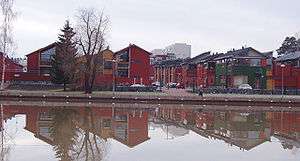
By the end of the 20th century there was pressure to develop the essentially untouched western side of the river. There was concern that growth would necessitate the construction of a second bridge across the river into the town, thus putting further strain on the wooden town. An architectural competition was held in 1990, the winning entry of which proposed building the second bridge. Plans for the western side of the river have progressed under the direction of architect Tuomas Siitonen, and both a vehicle bridge and a pedestrian bridge have been built. The design for new housing is based on a typology derived from the old storehouses on the opposite side of the river. Yet another new development entails the construction of a large business park called King's Gate (Kuninkaanportti in Finnish, Kungsporten in Swedish), which is under construction.
Porvoo railway station does not have regular train service, but special excursion trains from Kerava (either with steam locomotives or former VR diesel railcars from the 1950s) operate on summer weekends.[9]
Suomenkylä
Suomenkylä, or Finnby in Swedish, is a village north of the centre of Porvoo and beside the Porvoo river. Suomenkylä has an old school founded by Johannes Linnankoski in 1898. The village of Suomenkylä also has two burial places from the Bronze Age.
Kerkkoo
Kerkkoo, or Kerko in Swedish, is a village north of the centre of Porvoo and beside the Porvoo river. Kerkkoo has an old school which is over 100 years old and still active. From the village of Kerkkoo archeologists and townspeople found a stone axe from the Bronze Age.
Sports
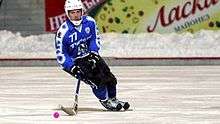
The local team Akilles Bandy plays in the highest division, Bandyliiga, and has become Finnish champions twice. Sami Hyypiä, a former football player for Liverpool FC and the Finnish national team is the main sports pride of Porvoo.

Notable people
- Remu Aaltonen, musician
- Carl Johan Adlercreutz, was a Swedish general and statesman
- Torvald Appelroth, Olympic fencer
- Albert Edelfelt, painter
- Hanna Ek, Miss Finland 2005
- Lauri "Cyanide" Happonen, former League of Legends world champion and professional player, now a streamer
- Sami Hyypiä, former captain of the Finland national football team
- Christer Kihlman, writer
- Sami Laakkonen, bandy player who scored the decisive goal in the final when Finland won the World Championship for the first time.
- Adolf Lindfors, Finnish wrestler and Olympic champion in Greco-Roman wrestling
- Johan Ludvig Runeberg, national poet
- Solveig von Schoultz, writer
- Seppo Telenius, writer and historian
- Ville Vallgren, sculptor
- Vladimir Kirillovich, Grand Duke of Russia, Romanov Dynasty
- Osmo Antero Wiio, professor, politician, author of Wiio's laws of communication
- Margaretha Zetterberg, pioneering textile and handcrafts worker
International relations
Twin towns — sister cities
Porvoo is twinned with the following cities:[10]
|
|
References
- ↑ "Area by municipality as of 1 January 2011" (PDF) (in Finnish and Swedish). Land Survey of Finland. Retrieved 9 March 2011.
- ↑ "Ennakkoväkiluku sukupuolen mukaan alueittain, maaliskuu.2016" (in Finnish). Statistics Finland. Retrieved 31 March 2016.
- ↑ "Population according to language and the number of foreigners and land area km2 by area as of 31 December 2008". Statistics Finland's PX-Web databases. Statistics Finland. Retrieved 29 March 2009.
- ↑ "Population according to age and gender by area as of 31 December 2008". Statistics Finland's PX-Web databases. Statistics Finland. Retrieved 28 April 2009.
- ↑ "List of municipal and parish tax rates in 2011". Tax Administration of Finland. 29 November 2010. Retrieved 13 March 2011.
- ↑ Jaakkola, Marianne (2007-11-19). "Yleistä Porvoosta" (in Finnish). Porvoo: City of Porvoo. Retrieved 7 January 2009.
- ↑ http://www.katajala.net/keskiaika/suomi/kaupungit.html
- ↑ http://www.kirkkojakaupunki.fi/uutiset/rikos-ja-rangaistus
- ↑ "Kerava-Porvoo Museum Train Timetable Summer 2009". Porvoo Museum Railway Society. Retrieved 14 October 2009.
- ↑ "The sister cities of Porvoo" (in Finnish). Porvoo City. Retrieved 5 March 2011.
External links
| Wikimedia Commons has media related to Porvoo. |
- City Porvoo – Official website
 Porvoo travel guide from Wikivoyage
Porvoo travel guide from Wikivoyage- King's Gate Business Park
- Porvoo Museum Railway – train service to/from Helsinki on summer Saturdays
Coordinates: 60°24′00″N 25°40′00″E / 60.4°N 25.666667°E
